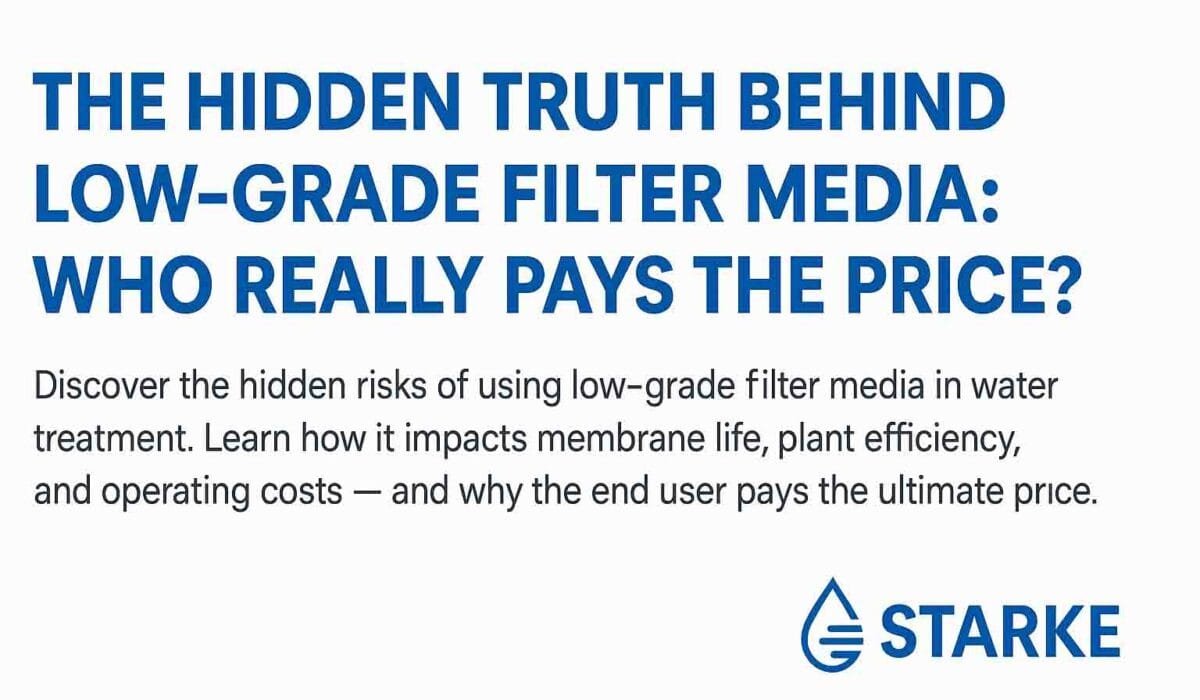The Hidden Truth Behind Low-Grade Filter Media: Who Really Pays the Price?
In the world of water treatment, system designers and EPC contractors often face the same dilemma: opt for quality filtration media upfront or cut costs with cheaper alternatives. While saving upfront may seem like a smart move, there’s a truth that many don’t realize until it’s too late – low-grade filter media cost far more in the long run.
And here’s the kicker: it’s not the seller or installer who pays – it’s the end user.
In this blog, we reveal the hidden pitfalls of using inferior media in water filtration systems, the science behind membrane fouling, and how smart filtration choices can protect performance, cost-efficiency, and reputation.
Why Low-Grade Filter Media is Tempting and Dangerous
Let’s start with the obvious: low-grade filter media is cheaper. Whether it’s sand, anthracite, or specialized media like iron removal granules, a lower-cost variant can cut the project budget significantly but at what price?
Here’s what usually happens:
The seller supplies media that’s unwashed, irregularly graded, or chemically unstable.
The contractor assumes membranes can always be replaced later.
The project appears “complete” on day one – but the real problems begin soon after.
The Real Science: What Happens Inside Your System
Low-grade media often fails to meet the required standards of:
Effective size (ES)
Uniformity coefficient (UC)
Bulk density
Surface cleanliness
Chemical composition
This leads to:
Incomplete removal of turbidity, iron, manganese, or organics
High SDI (Silt Density Index) readings
Chlorine breakthrough
Sludge formation
When poor-quality media is used, the first casualty is membrane health.
Membrane Fouling: What It Looks Like
Scaling: Due to untreated hardness and high TDS
Biofouling: Bacterial buildup from unfiltered organics
Particulate fouling: Suspended solids, silt, or dust particles pass through
Oxidative damage: Chlorine or iron particles degrade the membrane material
The result? Frequent chemical cleanings (CIP), higher power usage due to pressure drops, and premature membrane failure.
Who Pays the Real Price? The End User
Here’s the harsh truth: the end user bears all the long-term consequences, including:
Poor water quality
Higher energy costs
Frequent breakdowns and cleaning
Excessive chemical usage
Replacement of membranes every 1–2 years (instead of 5)
If the media had been chosen wisely, the user could avoid these headaches altogether.
A Real-World Cost Comparison (100 m³/day Plant Example)
| Component | With High-Grade Media | With Low-Grade Media |
|---|---|---|
| Membrane replacement (5 yrs) | ₹72,000 | ₹1,44,000 |
| CIP chemicals | ₹80,000 | ₹2,40,000 |
| Downtime losses | ₹35,000 | ₹1,75,000 |
| Total (5 Years) | ₹3,07,000 | ₹6,19,000 |
👉 Saving ₹50,000 on media costs ends up costing ₹3+ lakhs more.
What Makes a Filter Media “Low-Grade”?
🔻 Signs of Inferior Media:
No sieve analysis or grading report
Uneven particle size (causes channeling)
High clay, dust, or organic content
Chemically unstable or reactive under pH
Non-compliance with AWWA B100 / IS 8419
Qualities of High-Performance Media:
Effective size tailored to filtration goals
UC below 1.5 for consistent flow
Double-washed and kiln-dried
Free from organics, dust, and clays
Third-party certified and tested
The Starke Advantage: Premium Media That Delivers
At Starke Filter Media, we supply only certified and performance-driven media that protects your downstream membranes and boosts your plant’s life-cycle efficiency.
Our Flagship Solutions:
Purozite™: Zeolite-based processed media with superior turbidity and ammonium removal. Ideal for pre-RO filtration.
Anthracite: High-grade anthracite coal for TSS removal in dual or multimedia filters.
Iron Removal Media: Manganese dioxide–coated granules that oxidize and trap Fe/Mn at the inlet stage.
Quartz Sand: ISO/ASTM-graded sand, washed and dust-free for WTP/ETP installations.
Every batch comes with:
Sieve analysis curve
Manufacturer certificate
Origin certificate (India)
Bulk density & ES/UC values
Long-Term ROI: Quality Media vs. Short-Term Savings
Quality filtration media does more than just protect membranes:
| Benefit | Impact |
|---|---|
| Lower SDI | Protects RO/UF membranes |
| Fewer chemical cleans | Reduces O&M costs |
| Stable head loss | Energy efficiency maintained |
| Less sludge formation | Lower cleaning frequency |
| Extended membrane life | Fewer replacements, lower capital expenses |
| Consistent output quality | Satisfied clients and regulatory compliance |
The Responsibility of OEMs, EPCs, and Consultants
If you’re a water treatment OEM, EPC, or consultant, your filtration media selection reflects on:
Your technical knowledge
Your commitment to client satisfaction
Your long-term project performance
🛠️ Cutting costs today can damage your reputation tomorrow.
Smart Filtration Starts with Smart Choices
Here’s how to ensure you’re using the right media:
✅ Request detailed technical data sheets
✅ Check sieve curves, UC, and bulk density
✅ Verify chemical composition for application-specific needs
✅ Insist on third-party lab testing
✅ Partner with a trusted supplier like Starke
Conclusion: Don’t Compromise – Optimize
In water treatment, what you save upfront with low-grade filter media, you often lose tenfold in operational costs, performance issues, and membrane failure.
At Starke, we believe in helping you build systems that last not just systems that look good on paper.
Because when filtration fails, it’s always the end user who pays the price.
📞 Ready to Make the Smart Switch?
Talk to our technical team to find the right media blend for your WTP, RO, or ETP project.
📧 Email: starkeaqua@gmail.com
🌐 Visit: www.starkefiltermedia.com

